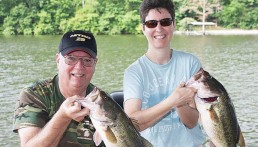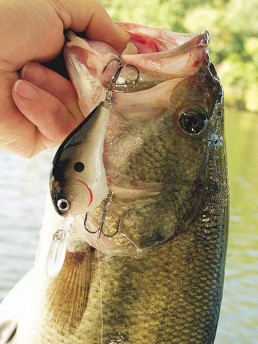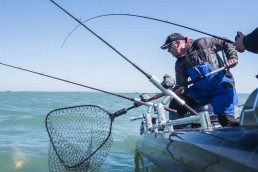Action Awaits Just Above the Dog Days Thermocline
SHARE THIS POST
The large-billed crankbait careened from one fist-sized rock to another until it stopped. A largemouth bass that inhaled it came to the boat, quickly owing to the warm upper layer of the water.
It was the dog days of August and the surface temperature was 87 degrees.
I had made a long cast across a deep submerged hump next to the river channel, left the reel in free-spool and then used the trolling motor to move in the opposite direction, effectively adding another 80 feet to my cast. I put more line out so my crankbait would run even deeper.
The objective was to bump across the top of a rocky ledge that was 18 feet deep, just above the thermocline. In Lake of the Ozarks and many highland reservoirs of the Mid-south, summer thermoclines occur anywhere from 12 to 20 feet deep. The often misunderstood thermocline can be a significant factor in the depth of both prey and predator fish in the summer. During hotter weather, the water in a deep lake forms three layers, distinguished by temperature and oxygen levels.
The thermocline is a thin layer of water sandwiched between the warm upper layer (epilimnion) and the lower, deeper, cold layer (hypolimnion). It occurs when the surface water heated by the sun floats over the colder, denser water. The thermocline marks that depth where the water temperature changes quickly.
The warm upper layer tends to carry satisfactory levels of oxygen where the lower, cooler water contains considerably less oxygen. This information is important since large gamefish seem to prefer a thin area of water at the top of the thermocline, not for reasons of comfort, but rather for physiological needs.
The book, Through The Fish’s Eye, stated: “A fish goes through life in a delicate balance of using more energy to catch its food than the energy derived from that catch.” Therefore, it makes sense that fish would hold in small areas that satisfy their physiological needs, including nearby forage.
Kevin VanDam has talked about a bass’s propensity for binge feeding.
Are you enjoying this post?
You can be among the first to get the latest info on where to go, what to use and how to use it!
“Summertime bass don’t like to expend too much energy cruising for food or chasing it down,” VanDam said. “They would rather hold in areas with high concentrations of food sources and then gorge themselves when the opportunity arises.”
According to guides in the area, finding walleyes and bass in the hot summer is easier than most people realize. You have to find where the thermocline intersects structure that is also holding forage where the walleyes and bass are.
Some ideal holding areas for fish include where the thermocline intersects points, channel swings, bluff ends or ledges, humps, shell beds and submerged brush piles. Since thermoclines can reach depths of 20 feet, special techniques are needed to fish these areas.
Today’s crankbaits can be effective for almost any depth encountered, as long as anglers use a quality rod and reel capable of handling lures weighing up to 3/4 ounce or more. The reel should be spooled with 12- to 14-pound-test fluorocarbon line or braided line of equivalent diameter.
Cranking a lure among rocks and debris causes frequent nicks in the line and dulls the hooks, so it is mandatory to check the line for dings every few minutes and retie often or as needed. Also, touch up the hooks with a sharpener each time you retie the line.
Another option is a Carolina-rigged plastic creature bait or a Texas-rigged plastic worm. These baits can cover any depth from 8 to 30 feet by increasing or decreasing the bullet or sliding weight. Dark colors work well in deep water. The lighter colors, like watermelon, work better in shallow water. You can even add a Bass Pro Shops 3-milimeter Worm Rattle to the plastic for a unique sound attractor.
A deep option that is rapidly gaining favor on the tournament trails is to cast and pump large spoons, like Eppinger’s 1-ounce Dardevle Spoon, Strike King’s 1 1/4-ounce Sexy Spoon or Talon Custom Lures’ Lake Fork Flutter Spoon.
Not every structure intersected by the thermocline during the dog days of August will hold fish, but where forage is present, bass, white bass, catfish or walleyes should be nearby.
MWO
SHARE THIS POST
Did you enjoy this post?
You can be among the first to get the latest info on where to go, what to use and how to use it!
Darrell Taylor
Darrell Taylor has fished for more than 65 years. During the past 25 years, Taylor has generated more than 2,000 published articles, columns and fishing reports. His writings received 14 peer-level awards from outdoor writer organizations, including the Association of Great Lakes Outdoor Writers “Excellence in Craft” Golden Glow Award, their highest recognition.




